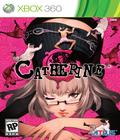Catherine is presented as an episode of the "Golden Playhouse" TV show, which is similar to "The Twilight Zone." The episode revolves around a man named Vincent, an average 30-year-old guy who's working a job he doesn't really enjoy and sort of lounging his way through life. His longtime girlfriend, Katherine, is encouraging him to get more motivated and look toward the future, but he mostly wants to hang out with friends and take things as they come. One night, he stays late at his favorite local bar, the Stray Sheep, and meets a vivacious young blonde named Catherine. One thing leads to another, Vincent has too much to drink, and the next morning, he wakes up in bed with Catherine. He is torn between his girlfriend and this new girl. As if that weren't enough, men around the city are turning up as desiccated corpses. There is a rumor that men who cheat on their significant others are cursed by a witch. The very night he meets Catherine, Vincent's dreams become terrible nightmares, where he finds himself climbing a deadly tower. If he can get to the top, his dearest wish will be granted. If he can't, he'll become another of those mysterious corpses.
Perhaps the most interesting thing about Catherine is that the advertising is pretty darned misleading. From the cover art and general tone, you'd think that it was some kind of pornographic game, but it's nothing quite like that. There's actually very little in the way of risqué material, and most of it is fairly subdued. Instead, the focus is on something that may be rather meaningful to the target demographic. Vincent is a man-child; he's in his 30s and has reached the point in his life where he is too old to continue acting like a kid, but unwilling to grow up and settle down. The primary conflict in the game revolves around that. Katherine, his girlfriend, represents stability and adulthood, while Catherine represents fun and the romance of youth.
While it isn't a meaningful work of art, Catherine does a surprisingly good job at tackling something more interesting than the usual video game fare. It isn't flawless, but for a large chunk of the story, it is down to earth. My biggest disappointment was when the more supernatural elements began to appear. They felt out of tone for what had previously been a very realistic game, barring the occasional mysterious death. Although there are a variety of different endings, I'd only consider a few of them to be "bad."
If I had one problem with the story, it is that a lot of it is set in stone. In much of the game, you can do very little to impact Vincent's actions. At best, you influence his attitude. Occasionally, his inner monologue changes depending on your previous choices, but this doesn't seem to have any significant impact on the plot or events. For example, if you tell Vincent to be a jerk to Catherine at every opportunity, she never really acts like it. If you have Vincent act mature or agree with Katherine every chance you get, she'll never really respond to your change in attitude. Things come together near the end, but much of the game feels very "on rails," and a lot of what you do has almost no impact on the main story.
Every night, Vincent visits the Stray Sheep, where he drinks with friends, talks to people at the bar and just hangs around. Your time at the Stray Sheep has a few different effects. Talking to various characters lets you find out more about their stories, and if you do it often enough, it can have an impact on them and solve their problems. It's not dissimilar to Persona's social link system, except that it mostly serves as fluff instead of being a defining gameplay mechanic. You get Achievements for helping out your bar mates, and that alone might be enough to encourage die-hard players to give it a chance. You'll occasionally get text messages from Catherine or Katherine, and you can respond on a line-by-line basis.
I disliked the inclusion of a very linear morality meter. When you're given a choice in dialogue, you're shown a meter, which leans towards either blue or pink. Blue represents maturity and Katherine-related choices while pink represents more of the freewheeling live-in-the-now kind of attitude and Catherine. The morality meter makes these choices feel more blatant. Instead of feeling like a natural part of the story, choices end up feeling like, "I got +10 to Catherine." The meter even pops up when you reach a point where it impacts the story, glowing and fluttering to let you know that the plot altered slightly. It would have worked a lot better if it were invisible, leaving the player to make his own choices without seeing the immediate impact. However, certain choices that come between the various nightmare levels are uploaded online. After you make the choice, you can see what everyone else playing Catherine chose as a selection. It's a minor feature, but it's relatively neat.
Most of Catherine's gameplay comes when you leave the Stray Sheep bar. Every night, Vincent falls asleep and has a terrible nightmare where he is one of many sheep who are being pursued by terrible monsters and forced to climb a seemingly endless block tower that is collapsing below them. To survive, Vincent has to reach the top of the tower before the night is over. If he fails, he dies — in the dream and in reality. The primary focus of these levels is figuring out the quickest way to reach the top of the tower. Vincent doesn't have many abilities; he can push and pull blocks and do some basic climbing and hanging, and that's about it.
As the game progresses, the blocks become more complex. At the outset, you only encounter normal pushable blocks, but normal blocks become increasingly rare. Some blocks are extra heavy and take Vincent longer to push. Others are trapped and will shoot spikes if he stands on them for too long, instantly killing him. Yet others are coated in ice and can send Vincent slipping and sliding, probably to his doom. There are blocks that send you leaping upward, blocks that explode, blocks that crumble beneath your feet, etc. Surviving in Catherine involves figuring out how to make use of each of these blocks. Most of the blocks can be dangerous, but they can also be useful. Standing on the spike traps can kill you, but successfully triggering one without dying turns it into a regular block. A heavy block make take longer to pull, but if the block is in the right position, the extra time is more useful than pushing two or three regular blocks.
At the end of every night, the game goes into a boss battle, which is functionally identical to the regular climbs but with one big twist. Instead of only racing against time, Vincent is chased by a monster, which varies depending on the day. Baddies can range from a skeletal version of one of Vincent's girlfriends to a horrible monster fetus crying out for its "daddy" as it scrambles after you. You must stay ahead of the monster to avoid dying, and this is made more difficult by the fact that each boss monster has an attack that can slow you down. An early boss can turn every block around you into a heavy block, slowing your progress and making it easier for them to catch you. Another can knock you down the blocks with a shockwave. A third can reverse your controls if you get hit by a rain of heart-shaped arrows. Each of these attacks can be avoided, but you must be in a position to avoid them. The control-reversing arrows can only be avoided if you have a surface over Vincent's head. If you are caught mid-climb, you're going to have to struggle with the reversed controls. These boss battles are probably the hardest aspect of the game, due in no small part to the fact that there is some element of randomness to them. The bosses don't always toss attacks at the same place or in the same way, and that forces you to adapt.
Scoring is also an important part of the game. Simply solving puzzles isn't going to earn you a high score, which unlocks new levels. To get a good score, you've got to solve puzzles quickly and keep your combo meter up. Each time you climb to a new maximum height, you earn one point on your combo meter. From that point, you have a brief period of time to find out how to climb higher still. If you don't, the combo is broken, and your score takes a hit. You only get the bonus to your combo the first time you reach a new maximum height. This means that getting a good score isn't just a matter of being fast, but making sure you conserve your combo time wisely. One tactic, for example, would be to use Vincent's ability to shimmy along the wall to avoid having to climb up a block to reach a new height. You'll save a few moments of combo time, which can be all but essential in getting a high score. In addition to combos, you also have to collect coins, which boost your score at the end of the stage. Most require you to go out of your way to get them, but it's worth it, as collecting coins can make it easier to get the precious gold.
Catherine can be pretty tough, although always in a fair way. Death is instant and can come quickly if you screw up. Fail to notice that you're standing on a trap tile, accidentally slide along an ice patch, or be too slow, and you'll be doomed in an instant. Extra lives are plentiful and often appear not long after checkpoints, but it's entirely possible to run low on lives if you get stuck in a particular area with no lives. Due to the generally free nature of the puzzles, it's also possible to put yourself in a situation where you can't advance. If you push the wrong blocks at the wrong times, you can trap yourself in an inescapable death trap. Fortunately, you can use the select button to "undo" a few steps at a time to revert to an earlier section of the game. The game is also very generous about helping you out. Between levels, you'll be able to talk to sheep who offer to teach you techniques. These techniques usually come in handy in the next level and offer a solution to what otherwise might be a serious roadblock. You can also buy items between stages to make it easier to get through, at the cost of making it harder to get a gold medal.
Catherine's puzzle aspect is exceptionally well designed, and it's the most fun I've had with a puzzle game in quite some time. The puzzles are fast-paced and a ton of fun to solve, since the player has a lot of control over how he solves the puzzles. While there's generally a fastest way through each section, there are only a handful of times that I felt shoehorned into the "fastest" way. Most of the time, you can puzzle your way through, and the game encourages you to use new techniques to get faster. The weakest moments are those when you feel like there's only one way to progress, but those are relatively few and far between. It's a frantic and fast-paced puzzle game and each level feels new, fresh and interesting. The pacing is solid, and the game doesn't run out of tricks before it runs out of gameplay.
In addition to the main story stages, there's also a huge amount of extra side content in Catherine. In the Stray Sheep bar, players can play an old-fashioned arcade game called Rapunzel, which functions almost identically to the main nightmare stages, but has over 100 of its own unique levels. There are also bonus unlockable stages that you can get to by earning gold medals on the regular levels, and three difficulty modes with modified versions of the puzzles. While you can get through the main story in about eight hours, doing everything the game has to offer will take a lot longer. The Rapunzel arcade game alone adds a bunch of extra value to the game.
Catherine is a really good-looking game. The anime-inspired visuals work very well, and the graphics manage to have a lot of personality. It's sometimes odd how exaggerated they can become, and it's difficult to buy the silly-looking Catherine as a "dream girl," but that is probably my biggest complaint about the graphics. The 2-D animated cut scenes manage to look worse than the main game in almost every way. I can't figure out why, since the 3-D models are better animated and more fluid than the low frame rate and cut-rate 2-D animation.
The voice acting is top-notch, and the characters sound natural and realistic in most conversations. There are a few times when it feels really "dubbed," but mostly this occurs when Japanese and America culture clash and the voice actors couldn't make it sound natural. Once again, the 2-D animation is the weakest point. Each cut scene is at a completely different volume from the rest of the game, making it shocking when everything suddenly sounds weird. The music is excellent, using classical tunes to counterpoint the dream visuals and add a sense of tension to the climb.
Catherine may not be the Persona 5 that people were hoping for, but it's a good game in its own right. The puzzle gameplay offers a lot of room for freedom and experimentation. Surprisingly, the story is engrossing and, while it can be too much like a soap opera at times, it keeps the player's attention the entire way through. Atlus is mostly known for its RPGs, but Catherine shows that it can shine in other genres, too. Catherine is one of the most exciting and interesting puzzle games to come out in years, and there is plenty of replay value for a $60 title, even if you're just trying to earn high scores and find hidden puzzles. Fans of puzzle games can find a lot to like, and even those who normally don't enjoy puzzles may like the welcome change of the fast, frantic gameplay.
Score: 9.0/10
More articles about Catherine












 Catherine is an unprecedented exploration of the pleasures and horrors of love. As Vincent, a man recently succumbed to the irresistible beauty of the game's titular diversion players find themselves swept into a treacherous love triangle.
Catherine is an unprecedented exploration of the pleasures and horrors of love. As Vincent, a man recently succumbed to the irresistible beauty of the game's titular diversion players find themselves swept into a treacherous love triangle.















































